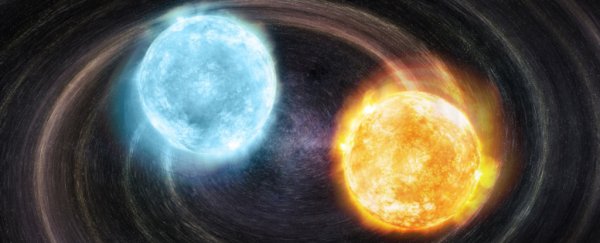An exciting pair of white dwarf stars spiralling in towards one another just became the latest addition to a promising pool of gravitational wave sources we could detect in the near future.
Of course, epic stellar amalgamations are the ultimate fate of many binary systems, when stars lean in too close to their dancing partners. Nonetheless, this new discovery – called J2322+0509 – is special. Here's why.
White dwarfs are the remnants of stellar cores, left over when stars like our own Sun have exhausted their fuel. J2322+0509 is a detached binary - it contains two white dwarfs with helium cores, swirling shockingly close, but not sharing any matter (as opposed to one star sucking up material from the other).
In fact, J2322+0509's orbital period – a brisk 20 minutes and a single second – amounts to the third shortest period of all known detached binaries. Within that brief window of time, each of the stars in the binary completes a full orbit of the other.
That's about three times longer than the current record-holder – two stars that orbit each other in less than seven minutes – but it's still an incredible stat, and one that begets even more amazing phenomena.
Theory predicts that white dwarf binaries with particularly tight orbits, such as this new discovery, can become a source of gravitational waves: invisible ripples in the fabric of space-time, generated as extremely massive objects change their speed.
Theoretically predicted over a century ago, gravitational waves were finally detected for the first time in 2015. That pioneering feat, accomplished by a huge collaboration of researchers at the Laser Interferometer Gravitational-Wave Observatory (LIGO), involved two distant black holes coalescing into a single black hole – an event that took place approximately 1.3 billion years ago.
But black hole mergers aren't the only thing that can produce gravitational waves. General relativity predicts that these powerful ripples in the fabric of the Universe can also emanate from other origins, including the rotation of neutron stars, the violence of supernovas, and, yes, the spiralling progression of dense white dwarfs in binary systems, as they pull in fast and close - just like J2322+0509.
"This pair is at the extreme end of stars with short orbital periods," says astronomer Warren Brown from the Harvard-Smithsonian Center for Astrophysics (CfA).
"And the orbit of this pair of objects is decaying. The gravitational waves that are being emitted are causing the pair to lose energy; in 6 or 7 million years they will merge into a single, more massive white dwarf."
 Artist's impression. (M. Weiss)
Artist's impression. (M. Weiss)
That fateful event may be millions of years away, but thankfully, we won't have to wait so long to find out more about J2322+0509's gravitational waves. In fact, it just became the first binary system of its kind to join an exciting candidate pool.
While we can't yet observationally confirm the gravitational waves being produced by this binary system, a specialised space observatory system, called LISA (Laser Interferometer Space Antenna), planned for launch in 2034, will have that specific capability.
Like a more nuanced version of LIGO, LISA will consist of three separate satellites floating in space, millions of kilometres apart. Connected by a single laser beam, the system will be able to tell if the satellites move as a result of gravitational waves, even if the movements are so subtle, they only register on the subatomic scale.
For LISA to deliver, though, this ambitious project needs a ready cohort of gravitational wave source candidates to study and verify. That's why finding objects like J2322+0509 is crucial today – even if it's only an exotic breadcrumb for now, guiding a path to the even bigger discoveries of tomorrow.
"Verification binaries are important because we know that LISA will see them within a few weeks of turning on the telescopes," says astrophysicist Mukremin Kilic from the University of Oklahoma.
"There's only a handful of LISA sources that we know of today. The discovery of the first prototype of a new class of verification binary puts us well ahead of where anyone could have anticipated."
As the researchers explain, this particular kind of binary is expected to be a common phenomenon, once LISA is up and running.
"Theories predict that there are many double helium-core white dwarf binaries out there," says Brown.
"This detection provides an anchor for those models, and for doing future experiments so that we can find more of these stars and determine their true numbers."
The findings will be published in The Astrophysical Journal Letters.
